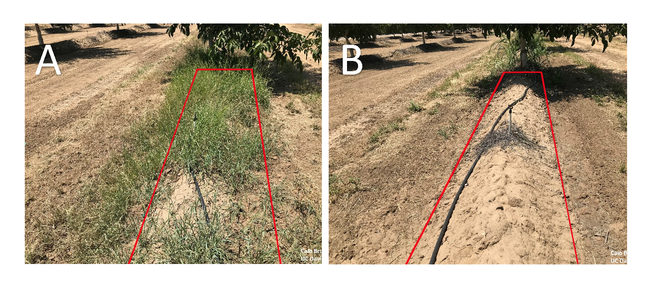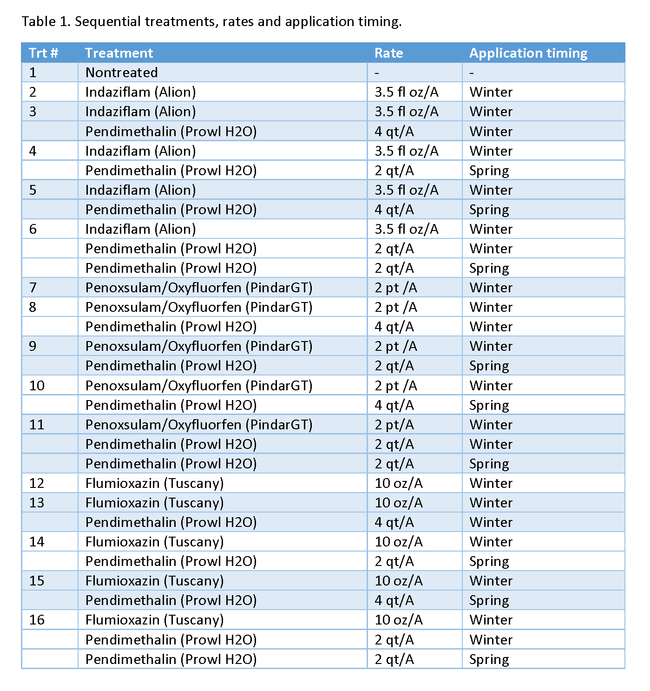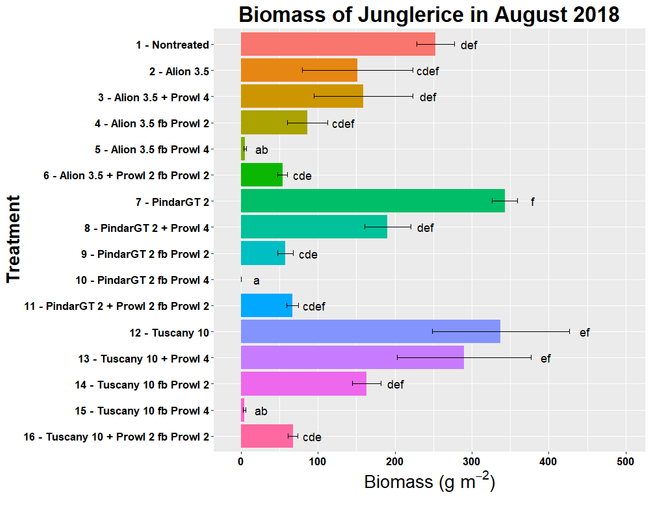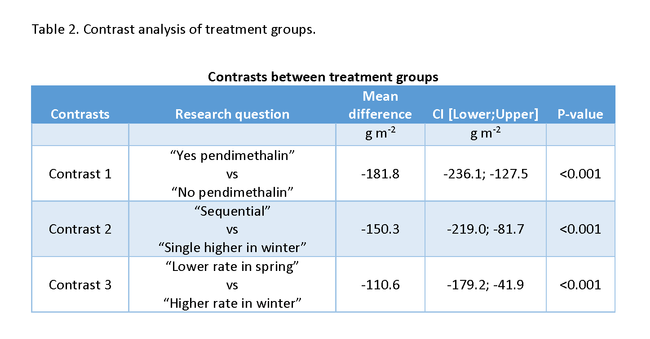Summer grass weed species are becoming more troublesome in orchards in the Central Valley of California. Feather fingergrass, junglerice, sprangletop and threespike goosegrass, to name a few, are summer grass weed species that germinate (or in some cases, resume growing) when the soil temperatures start to rise in the spring, develop during the summer and complete their life cycle in the fall. With such a life cycle, summer grass weed species reach their maximum biomass accumulation late summer/early fall – coincidently when harvest operations are taking place – if previous weed management approaches were inefficient. To make matters worse, some of the mentioned weed species have some degree of glyphosate resistance/inherent tolerance (see blog post).
A common weed control program in tree nut orchard crops in California consists of a winter preemergence/postemergence herbicide tankmix application, followed by a burndown application in the spring with a postemergence herbicide, and then an additional burndown herbicide application before harvest. The spring postemergence herbicide application is crucial because it controls the escapes from the winter treatment. However, because most of the burndown herbicides have no residual activity (e.g. glyphosate, glufosinate, paraquat) or relatively short residual activity (e.g. oxyfluorfen), weeds that germinate after the spring treatment may still develop during the summer. Finally, in the summer, the weeds will grow larger and become less prone to control either because of their size or because of resistance to common summer POST herbicides (i.e. glyphosate). In this context, season-long weed management strategies become crucial to prevent weeds from interfering with irrigation systems or harvest operations in orchard crops in California.
For several years, our group has discussed the concept of using sequential preemergence herbicide programs in tree nuts as a way to specifically target these summer emerging weeds (see blog post). The idea behind the sequential approach is to apply a second PRE herbicide shortly before germination of the summer species rather than trying to achieve summer weed control with only the PRE herbicides applied in the winter. This approach more specifically targets those summer-emerging species and may at the same time provide economic and environmental benefits by reducing over-treatment.
To evaluate this concept in the real world, we conducted two field trials in walnuts in Tulare County, California, from December 2017 to August 2018. The treatments consisted of a December application of one of three common preemergence herbicides. On top of this, pendimethalin was tankmixed with the December treatment, applied as a sequential treatment in March, or split with part of the pendimethalin treatment applied in December and part in March. (Table 1). The standard herbicides were indaziflam (Alion), penoxsulam/oxyfluorfen (PindarGT) and flumioxazin (Tuscany). At both application timings, glyphosate + glufosinate was added to the preemergence treatments to ensure that all weeds evaluated originated from seed and not from regrowth. Junglerice was the predominant summer weed species at both sites. Junglerice control was evaluated monthly and aboveground biomass was collected in August before trial termination.
Our results show that both sites yielded similar results, so we will focus on one of the sites for clarity. Figure 1 shows biomass assessments in August. We observed a general trend that the addition of pendimethalin enhanced junglerice control throughout the crop growing season. Not surprisingly, summer grass control was best with all three winter foundation herbicides when followed with the high rate of pendimethalin (Prowl 4 qt/A) in the spring.
We also conducted a contrast analysis with the junglerice biomass data. A contrast analysis is basically a comparison between groups of selected treatment(s) and may be helpful to answer specific questions. Our initial research questions were:
- Does the addition of pendimethalin reliably enhance junglerice control?
- Can a sequential application of the lower rate of pendimethalin (Prowl 2 qt/A in winter plus Prowl 2 qt/A in spring) perform as well as a single pendimethalin application with the higher rate (Prowl 4 qt/A) in the winter?
- Can the higher pendimethalin rate (Prowl 4 qt/A) in the winter perform as well as the lower pendimethalin rate (Prowl 2 qt/A) in the spring for control of summer-emerging grasses?

The results of our contrasts analysis are shown in Table 2. We observed that the addition of pendimethalin to the system (either in the winter or spring) enhance junglerice control, reducing the average biomass of this weed to 181.8 g m-2 (>70% enhanced control – Contrast 1). From contrast 2, we observed that a sequential application of lower rates of pendimethalin (Prowl 2 qt/A in winter + Prowl 2 qt/A in spring) provides a better control of junglerice than a single application of the higher rate of pendimethalin (Prowl 4 qt/A) in the winter. Lastly, from Contrast 3, we observed that the lower rate of pendimethalin applied in the spring actually outperformed the higher rate of pendimethalin applied in the winter.
When considering only the summer emerging grasses, the lower rate of pendimethalin (Prowl 2 qt/A) in the spring generally outperformed the higher rate of pendimethalin (Prowl 4 qt/A) applied in the winter but was not always quite as good as the sequential treatment. Because the higher rate of pendimethalin in spring provided excellent control and the lower did not, this is not likely due simply to early-germinating junglerice. Instead, under heavy weed pressure, the spring treatment with the lower rate is not quite enough without the winter component.
The experiments conducted in this research focused primarily on the control of summer grass weed species, and the weed community present in specific fields will determine the adequate herbicide treatment to be adopted. In areas where summer weed species are the major issue, shifting some or all of the pendimethalin component of the herbicide program may significantly improve performance relative to the winter-only PRE approach. However, in areas where winter grass weed species (e.g. annual bluegrass, Italian ryegrass) are also troublesome, the sequential pendimethalin application may be more appropriate. The bottom line is that we can, in some instances, improve or maintain weed control outcomes using less herbicide by carefully considering the biology of the weed, our weed control goals, and the weed management tools at our disposal.
A more detailed report including data from both Tulare sites and also the efficacy of sequential applications for other weed species is coming up and will be shared in this blog soon.
Caio Brunharo is an Assistant Professor Weed Science at Oregon State University and Brad Hanson is a Cooperative Extension Weed Science Specialist at UC Davis.


